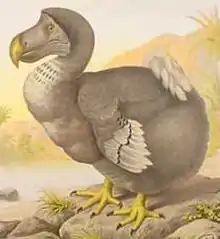Bird extinction
Out of the approximately 11,154 known bird species, 159 (1.4%) have become extinct, 226 (2%) are critically endangered, 461 (4.1%) are endangered, 800 (7.2%) are vulnerable and 1018 (9.1%) are near threatened.[1] There is a general consensus among scientists who study these trends that if human impact on the environment continues as it has one-third of all bird species and an even greater proportion of bird populations will be gone by the end of this century.[2]

Since 1500, 150 species of birds have become extinct.[3] Historically, the majority of bird extinctions have occurred on islands, particularly those in the Pacific. These include countries such as New Zealand, Australia, Fiji, and Papua New Guinea.
Some species are not extinct and seem numerous, but exist in highly reduced numbers from previous years. For example, the Wood Thrush population in North America has declined 50% in the last 50 years. According to the American Bird Conservatory, in the Western Hemisphere 12% of bird species are declining at a rate such that they will be extinct within the next century.[4]
Causes of bird extinction
Human activity is the greatest cause of bird extinction around the world. The top human causes of bird extinction involve: the increased human population, destruction of habitat (through development for habitation, logging, animal and single-crop agriculture, and invasive plants), bird trafficking, egg collecting, pollution (in fertilizers impacting native plants and diversity, pesticides, herbicides directly impacting them as well as the plant and animal food birds eat, including the food for their food source further down along the food chain), and climate change and global warming.[5] Due to the increasing human population, people seek additional space from what was once wild. This is a major contributor to extinction.[6]
Natural
As climate change is caused by a variety of activities, the effect that climate change has on bird extinction is immense. Due to the rapid changes in temperature and climate the bio diverse earth can not progress with these factors.[6] Severe weather conditions and long seasons, as well as a chemical atmosphere within their surroundings, makes it difficult for many species of birds to keep up with.[6] In Hawai'i, climate change is responsible for the decline in the population in Hawaiian forest birds and is resulting in an increase of avian malaria (plasmodium relictum). Because the dynamics of malaria are influenced by ambient temperature and participation patterns, the predicted climate changes are expected to increase the occurrence of avian malaria.[7]
Sea level rise may flood islands killing the birds and other animals native to islands causing extinction.
Disease
Each species of birds carries defense mechanisms like resistances and the ability to fight disease.[6] With the changing climate and atmosphere, many species are losing their ability to fight particular diseases. These bird species are becoming more susceptible to disease, which results to the downfall of extinction. The most common disease affecting birds is Salmonellosis, which originates from the Latin name of salmonella. Infected birds pass bacteria in their fecal droppings, and other birds then become ill when they eat food contaminated by the droppings.[8]
By region
Australia
In June 2020 the Royal Society of South Australia published a list of 95 Australian bird fossils. The list includes three species of huge flamingos from the Kati Thanda-Lake Eyre and Lake Frome areas of South Australia, which were estimated to inhabit the area for 25 million years before becoming extinct about 140,000 years ago, most likely from drought. There were also penguins measuring about 2 metres (6 ft 7 in) tall, which lived between about 60 million and 30 million years ago, dying out in the Oligocene. Researcher Trevor Worthy said that little was known about the evolution of birds in Australia, which stands at about 1,000 species.[9][10][11]
References
- IUCN 2020. "The IUCN Red List of Threatened Species". IUCN Red List of Threatened Species. Version 2020-21. Retrieved 2020-03-28.
- Gerardo Ceballos, Anne H. Ehrlich, and Paul R. Ehrlich (2015). The Annihilation of Nature: Human Extinction of Birds and Mammals. Baltimore, Maryland: Johns Hopkins University Press. ISBN 1421417189 - via open edition. "65"
- Loehle, Craig; Eschenbach, Willis (2012-01-01). "Historical bird and terrestrial mammal extinction rates and causes". Diversity and Distributions. 18 (1): 84–91. doi:10.1111/j.1472-4642.2011.00856.x. ISSN 1472-4642.
- "Extinction", American Bird Conservatory, Accessed July 4, 2019.
- Diamond, J. M.; Ashmole, N. P.; Purves, P. E. (1989-11-06). "The Present, Past and Future of Human-Caused Extinctions [and Discussion]". Philosophical Transactions of the Royal Society of London B: Biological Sciences. 325 (1228): 469–477. doi:10.1098/rstb.1989.0100. ISSN 0962-8436. PMID 2574887.
- "Extinction - Causes". people.uwec.edu. Retrieved 2016-05-17.
- Wei, Liao; Atkinson, Carter T.; LaPointa, Dennis A.; Samuel, Michael D. (2017). "Mitigating Future Avian Malaria Threats to Hawaiian Forest Birds from Climate Change". PLoS ONE. 12 (1): e0168880. doi:10.1371/journal.pone.0168880. PMC 5218566. PMID 28060848.
- "Common Bird Parasites & Diseases". Mass Audubon. Retrieved 2016-05-17.
- Corvo, Shannon (1 July 2020). "Outback flamingos, giant penguins on new list of extinct Australian birds". ABC News. Australian Broadcasting Corporation. Retrieved 3 July 2020.
- Flinders University (26 June 2020). "No leg to stand on for Australia's flamingos". Phys.org. Retrieved 3 July 2020.
- Worthy, Trevor H.; Nguyen, Jacqueline M. T. (2 January 2020). "An annotated checklist of the fossil birds of Australia". Transactions of the Royal Society of South Australia. Informa UK Limited. 144 (1): 66–108. doi:10.1080/03721426.2020.1756560. ISSN 0372-1426. Retrieved 3 July 2020 – via Taylor & Francis online.
